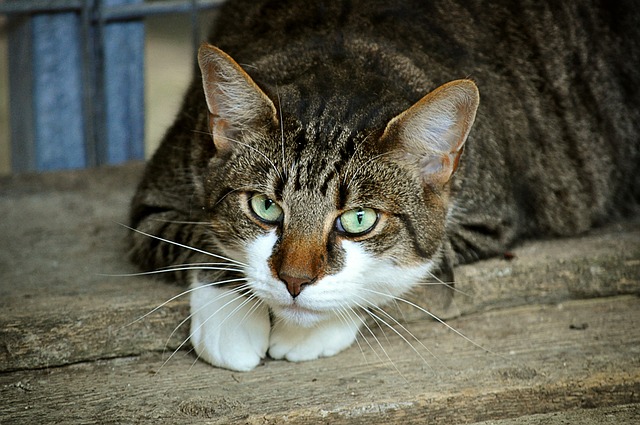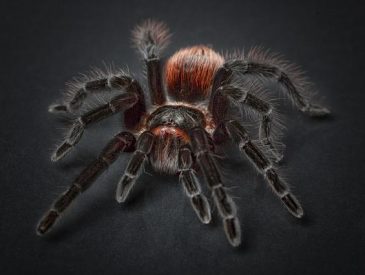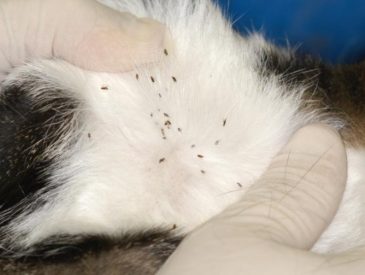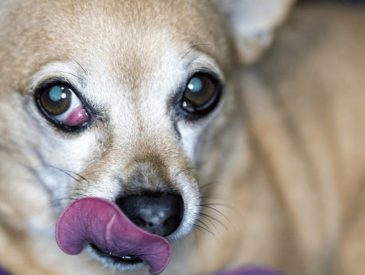To start with, why are my cat’s eye watering?
Reasons for my cat’s eye watering maybe include: normal film and discharge, conjunctivitis, allergies, foreign object in eye or a scratch on the cornea, infection, dry eye…
When accompanied by other symptoms, watering cat eyes can be a sign of more serious issues like an infection or conjunctivitis. Keep an eye on your cat’s symptoms, and if they worsen or persist, consult your veterinarian.
Please continue reading for more information.
Table of Contents
Cat Eyes Watering: Possible Causes
Watery eyes are a typical sign of many different conditions that a cat may be experiencing, just like runny noses are in humans. It’s also simple to worry and feel overwhelmed when our furry friends are having unpleasant symptoms. Read the list of potential causes below to get a better idea of what your pet may be going through.
Normal Film And Discharge
Cats’ eyes are naturally covered in a layer that lubricates, shields debris, supplies nutrients, and fights bacteria. It’s usually nothing to worry about if you notice a little wetness under your cat’s eyes; this is just their body doing what it needs to in order to keep them safe.
Excessive discharge could be a sign of a more serious issue or it could simply go away by itself. The first thing you should do if your cat begins to frequently discharge fluid from its eyes is to simply watch them until it either stops or becomes more obvious that something is wrong.
Conjunctivitis
This eye condition, also known as “pink eye,” is one of the most prevalent eye issues in cats. You may have also heard of it by this name. It results in eye inflammation, which can make one or both of their eyes red, swell, and become light-sensitive. The tears in your cat’s eyes might be clear and teary or they might be very thick and mucus-like.
Many different conditions, such as an infection, an allergy, or even dust, can lead to conjunctivitis. Although highly contagious, the condition usually goes away on its own without requiring veterinary care. If your cat exhibits any signs of eye pain, such as redness, swelling, discharge, watery eyes, etc.) it’s best to get in contact with your vet straight away, as poorly eyes can deteriorate very quickly.
Many of the below-listed causes of weepy eyes will also result in conjunctivitis because conjunctivitis is a symptom of many different eye conditions rather than a disease in and of itself.
Allergies
It’s interesting to note that cats can have watery eyes because they can have allergies to many of the same things as people. Pollen, mildew, mold, dust, some medications, perfumes, and cleaning products are examples of potential allergens. Take your cat to the vet if you think they might have an allergy so they can examine them and advise you on what to do next.
See more about What Do Cat Fleas Look Like To The Human Eye?
Foreign Object In Eye Or A Scratch On The Cornea
There may be a scratch on the cornea (the clear part of the eye), or a foreign object that is irritating your cat’s eye if they appear to be blinking, have an eye shut, are squinting, or are repeatedly pawing and scratching at their eye. It is critical to take them to a veterinarian as soon as you can if there is a scratch on the cornea or something lodged there. Depending on what your cat has stuck in their eye, it could result in more severe harm, especially if the cat scratches at its eyes while attempting to remove the object.
In these situations, an in-person visit with a veterinarian is required because a telemedicine visit won’t be able to accurately assess your cat’s eye and tear duct, and an in-person visit with a veterinarian is unquestionably required to have any foreign obstruction, if any, removed.
Infection
Cats who have bacterial eye infections must be quickly diagnosed because they can be serious. Your cat may exhibit behavioral signs like lethargy or loss of appetite in addition to producing a gooey, yellow or green discharge from the infected eye.
Your veterinarian will likely stain your eye if you have an eye infection to make sure there isn’t a scratch on the cornea before giving you ophthalmic antibiotic drops to help you get rid of it. A veterinarian may occasionally recommend oral antibiotics as well. The most crucial thing is to treat your cat’s eye infection seriously because, in some cases, leaving the infection untreated can result in permanent vision loss. It’s a good idea to schedule an appointment as soon as you can with your neighborhood vet.
Dry Eye
Dry eyes are brought on by a persistent lack of tear production, which causes irritation and scarring on the surface of the eyes. The eyes may also appear painful and red. Cats who have dry eyes may even go blind if the condition is not treated. Due to the insufficient production of fluid, the discharge from dry eyes is typically yellow and gooey. Cats can develop dry eyes for a variety of reasons, such as viral infection, nervous system injury, immune-mediated disease, and drug exposure.
Epiphora
A problem with the tear ducts that drain tears from the eye to the nose is another reason why cats’ eyes weep. The most frequent cause of this is a duct blockage, but it can also be brought on by sinusitis or rhinitis because these conditions cause swelling in the tissue there. The genetic condition known as distichiasis, which causes abnormally small hairs to grow underneath the eyelid, can also cause excessive crying.
Glaucoma
Serious pain and eyeball swelling are possible effects of feline glaucoma. The eye of your cat may enlarge or appear visibly irritated, and your cat may exhibit other behavioral indications of pain and discomfort.
Cats with glaucoma should seek immediate medical attention from a veterinarian. This excruciating condition can appear out of nowhere and advance quickly. In many cases, the cat’s eyesight has already suffered irreparable damage by the time symptoms manifest.
Get your cat to a vet as soon as you can if you suspect that they are experiencing feline glaucoma in order to prevent the condition’s symptoms from getting worse or the damage from becoming irreversible.
Cold Or Upper Respiratory Infection
Your cat most likely has a cat cold or feline upper respiratory infection if they exhibit the typical symptoms of a cold or upper respiratory infection, such as watery eyes, runny nose, and sneezing, that you would expect from a human cold.
Within a week or so, many cat colds resolve on their own without the need for medical attention. However, it’s time to make an appointment with your veterinarian if your cat’s symptoms worsen or do not get better in a few days.
The distinction between a cold and allergies can be challenging in some situations, it should be noted. A virtual visit can assist in identifying the problem’s root cause and whether it necessitates more urgent attention.
What Can You Do If Your Cat’s Eye Is Watering?
Depending on whether your cat has any other symptoms, you should decide what to do if you notice that their eyes are watering. You probably don’t need to take any action, for instance, if you only experience a slight wateriness for a few days and it eventually goes away on its own.
However, if you experience additional symptoms like itchiness, redness, squinting, or swelling around the eye, this may indicate a more serious condition like pink eye, allergies, an eye infection, or even glaucoma. It’s time to take your cat to the vet if you notice any additional symptoms, persistent watery eyes, or obvious pain or discomfort in your cat.
If your cat does have an infection or other serious cause of irritation in their eye, your vet will likely prescribe one of the following:
- Eye drops
- Ointment
- Eye rinse
- Antibiotics
- Eliminating allergens from environment
- A cone to keep your cat from scratching or rubbing at its eyes
- Diet or behavioral changes
Dutch can help if your cat has allergies that are causing itching, watery eyes, and irritation. It would be our pleasure to put you and your little pal in touch with a pharmacy that can provide secure and efficient allergy medication through Dutch’s network of veterinarians.

Symptoms Of Eye Issues In Cats
Water And Glassy Looking Eyes
Cats can develop itchy, watery eyes from allergies, which are surprisingly common in cats. Pollen, dust from mold and mildew, household cleaners, perfumes, and some medications are examples of common allergies that could harm your cat’s eyes. Keeping your cat away from the allergen may help to solve the problem. If you are unable to identify the source of your cat’s watery eyes, a trip to the vet is necessary. Your veterinarian will be able to rule out more serious causes for your cat’s watery eyes and suggest ways to help your cat feel more comfortable with their eyes.
Blinking, Squinting And Pawing At Eyes
A trip to the vet is necessary if your cat has watery eyes and is blinking too much, squinting, or pawing at its eyes. It’s possible for your cat to have a blocked nasolacrimal duct (tear duct) or a foreign body trapped in the eye that is irritating it. Although nasolacrimal obstructions are less common in cats than in dogs, they can still cause tears to overflow and run out of the eye.
Red And Inflamed Eyes
The likelihood that your cat has conjunctivitis, or pinkeye, increases if its eyes appear red and inflamed. Swollen eyes and increased sensitivity to light are two additional indicators that your cat may have conjunctivitis. Conjunctivitis is a common eye condition in cats that can be brought on by a variety of things, including an allergy or an infection with the feline herpes virus. While conjunctivitis is typically easy to treat, untreated cases can develop into more serious complications. Because of this, it is always best to visit your veterinarian if your cat’s eyes have started to turn red and water. Your veterinarian may prescribe eye drops or an ointment, depending on how badly your cat’s eyes are itchy.
Sticky, Yellow Or Green Discharge
Like in humans, an infection is typically indicated by a gooey or sticky discharge coming from your cat’s eyes. While green or yellow discharge may indicate your cat has a bacterial infection, a clear discharge frequently denotes a viral infection. Early diagnosis and treatment of eye infections can help to prevent later, more serious complications. Ophthalmic antibiotic drops, gels, or ointments may be used in the treatment of bacterial eye infections in cats. Except when a systemic infection is the cause of your cat’s eye issue, oral medications are typically not necessary.
Obvious Pain Or Swelling
It’s time to take your cat to the vet so they can check for glaucoma if they are showing clear signs of pain, the eyeball is bulging, or there is noticeable swelling around the cat’s eye. Glaucoma symptoms in cats signal the need for immediate veterinary care. The onset and progression of this excruciating condition can be incredibly quick. In most cases, a significant portion of the cat’s eyesight will be irreparably lost by the time symptoms become apparent.
Nasal Discharge And Sneezing
Your feline friend most likely has a feline upper respiratory infection or a cat cold if they exhibit symptoms of a human cold, such as watery eyes, runny nose, and sneezing. Most cat colds will go away on their own in a week, so make an appointment with your veterinarian if your cat’s symptoms worsen or don’t get better in a few days.
Do Some Cat Breeds Have A Higher Chance Of Having Watery Eyes?
Any age, sex, or breed of cat is susceptible to conjunctivitis and congenital allergies.
There are numerous ways to spread bacterial infections that can result in conjunctivitis. For example, in a home with multiple cats or between cats in the outdoors, bacteria can be transmitted. But even if your cat is an only child who prefers the security of indoor living, they can catch bacteria if they come into contact with contaminated objects, like that filthy shoe they keep tearing apart. Regardless of the cat’s breed, exposure to bacteria can result in bacterial infection.
Every breed of cat is susceptible to the most prevalent cause of conjunctivitis, feline herpes virus. In fact, over 90% of cats live with FHV.4
Similar to dogs, any cat—regardless of breed—can be born with an innate allergy.
When Should You Bring Your Cat To The Vet For An Eye Exam?
Visit the vet if your cat’s eyes continue to swell for more than a day or two, or if they are displaying signs of pain or an infection. Your veterinarian will be able to look at your cat’s eyes and suggest suitable treatments to help your cat feel better.
Read about How Many Eyes Does A Butterfly Have?
Tips To Keep Your Cat’s Eyes Healthy
Cat parents can take precautions to avoid eye injuries and other potential causes of watering eyes, even though some bacterial exposure is unavoidable (after all, cats are a curious lot), viral infections are difficult to predict, and congenital allergies must simply be managed. These include:
- Dust and sweep regularly – Maintaining a clean home environment can be achieved by cleaning frequently and even by using an air purifier. You can avoid harmless eye-watering in cats and possibly lessen their exposure to bacteria in the air by lowering the likelihood that your cat will get dirt or dust in their eyes.
- Take good care of your cat’s toys – To keep toys free of dangerous bacteria, wash them frequently. Discard any toys that have started to fall apart so that no one will get hurt by any loose parts.
- Treat your cat’s skin regularly – You can prevent common skin, eye, mouth, and ear conditions in cats by using Vetericyn Plus Feline Antimicrobial Facial Therapy to keep their skin free of bacteria that can cause conjunctivitis.
Conclusion
Cats naturally lubricate their eyes with tears, but if your cat has persistent wetness, crusty buildup in the corners of her eyes, or brownish staining of the fur nearby, her eyes may be too watery.
It’s time to see your vet if you also notice redness, squinting, greenish discharge, swelling around the eye, or any abnormal appearance to the eye itself.
I appreciate your reading.





